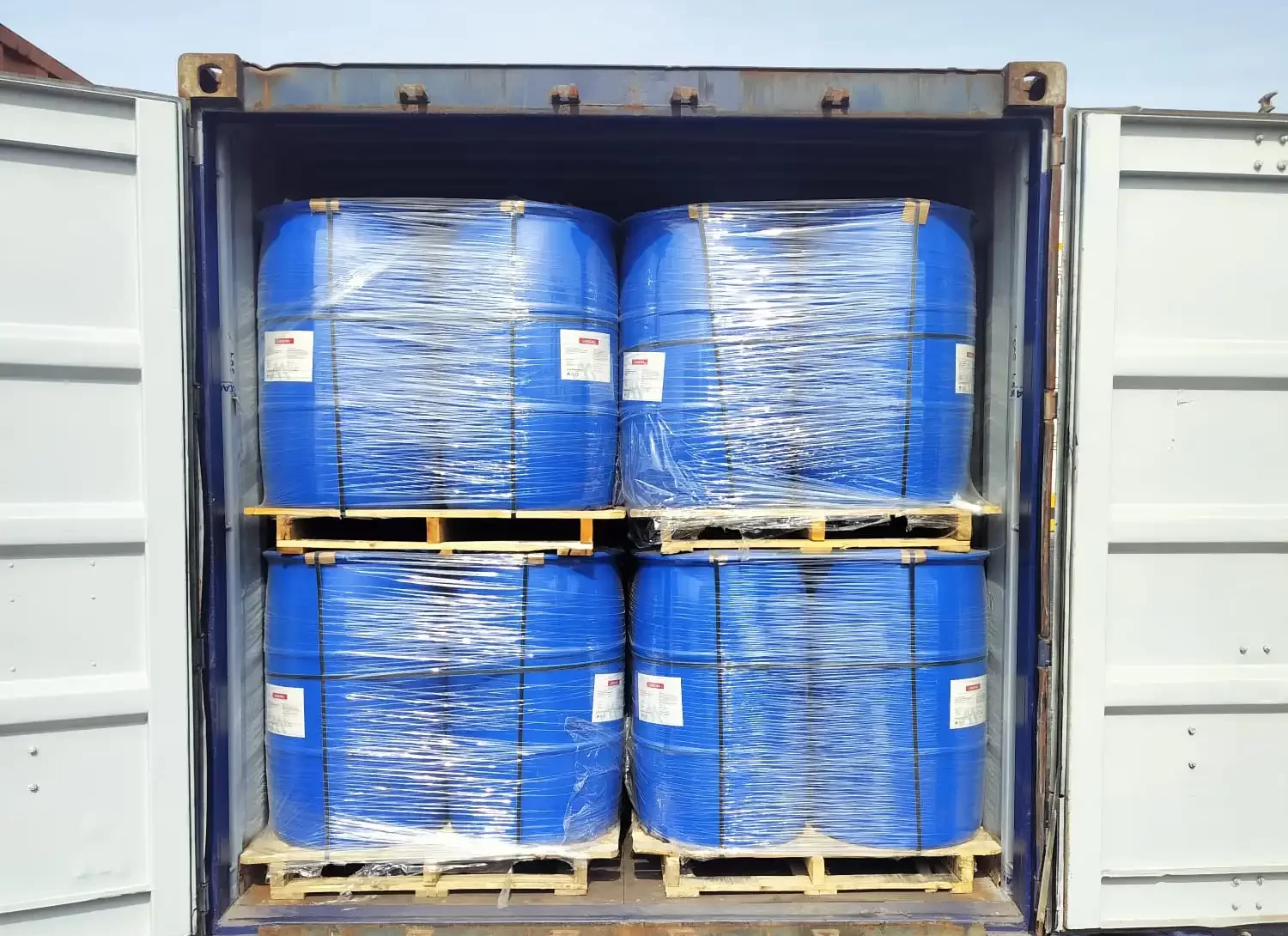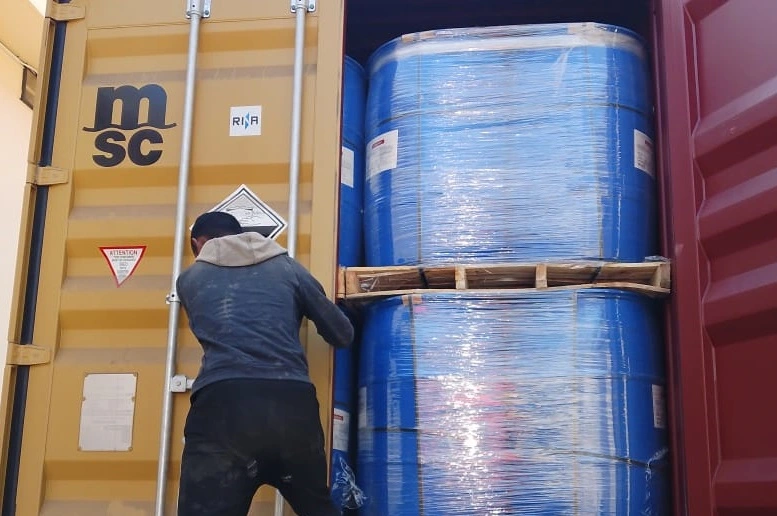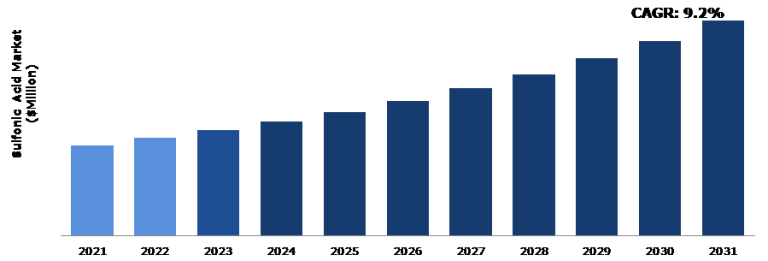 LABSA 97%
LABSA 97%
WHAT IS LABSA?
Linear alkyl benzene sulfonic acid, also known as LABSA, is a synthetic chemical surfactant, a widely used industrial detergent. Used in washing powder, detergent powder, oil soap, cleaning powder and detergent cake. LABSA is an anionic surfactant whose molecules are characterized by a hydrophilic and hydrophobic group. This non-volatile chemical compound is synthesized through the sulfonation process. Sulfonation reagents include sulfuric acid, chlorosulfonic acid, sulfamic acid and diluted sulfur trioxide. The properties of LABSA differ in chemical and physical properties depending on the length of the alkyl chain. This results in formulations that find many applications. The resulting surfactants are used in the chemical industry to improve the contact between water and minerals. Most anionic surfactants, including LABSA, are non-toxic in nature. However, prolonged exposure to these surfactants can irritate and damage the skin through disruption of the lipid membrane that protects the skin and other cells. On the other hand, biodegradability is determined by the hydrophobic hydrocarbon group of the surfactant. LABSA is one of the largest synthetic surfactants by volume due to its low cost and high performance. Apart from that, Linear alkyl benzene sulfonic acid can be dried in the form of a stable powder. This chemical is biodegradable and environmentally friendly. This substance and its derivatives are widely used chemical compounds in the industry of beauty and personal care products. It is also used as a raw material for the production of caprolactam, a precursor of nylon. In this reaction, hydrogen sulfide is used as an equivalent of elemental sulfur. In some cases, the above substance can be used as an additive in special racing car fuels because it helps to ignite their fuel quickly. LABSA is a purple liquid and has various uses due to its surfactant properties.
WHAT ARE THE LABSA USAGE AREAS ?
This substance cleans surfaces due to its anionic surfactant nature. Detergents containing this substance only work when mixed with water. Water helps wash away the remaining dirt particles that detergents need to remove. This is the reason why this product is a popular ingredient in washing detergents. You can contact us for buying and selling industrial chemicals, especially wholesale sales.
- LABSA is mainly used in the detergent industry in the production of washing powder, detergent powder, detergent tablet, liquid soap, oil soap, scouring stick and cleaning powder.
- This chemical finds application in anionic special formulations.
- The quality of pesticide sprays can be improved by using LABSA.
- Linear alkyl benzene sulfonic acid is used as a washing and mercerizing agent in the textile industry.
- The watercolor surface area is increased using LABSA.
- It is used in small quantities as a wetting agent and also as an emulsifier, together with other surfactants, for lathering toilet soaps.
- Thanks to its high active substance content and low salt content and miscibility with water, Linear alkyl benzene sulfonic acid is used in the polymerization of emulsions and in the production of binding agents, emulsifiers, pesticides, household and industrial cleaners.
ADVANTAGES OF LABSA
Linear Alkyl Benzene Sulphonic Acid is one of the largest synthetic surfactants by volume due to its low cost and high performance. Apart from this, LABSA can be dried to a stable powder form. This chemical is biodegradable and environmentally friendly.
IN WHICH SECTORS IS LABSA USED ?
Linear alkyl benzene sulfonic acid is chiefly used in the detergent industry for the manufacture of washing powder, detergent powder, detergent cake, liquid soap, oil soap, scouring bar and cleaning powder. This chemical finds applications in anionic specialty formulations. The quality of pesticide sprays can be improved from it. Linear alkyl benzene sulphonic acid is used as a washing and mercerizing agent in the textile industry. The surface area of distempers is increased using Linear alkyl benzene sulfonic acid. It is used as a wetting agent as well as an emulsifier in small quantities along with other surfactants, for foaming of toilet soaps. Owing to its high active matter content and miscibility with low salt content and water, Linear alkyl benzene sulfonic acid is used in the polymerization of emulsions and in production of coupling agents, emulsifiers, agricultural herbicides, household and industrial cleaners.
- Production of cleaning products
- Production of personal care products
- Agrochemicals
- textile sector
WHAT ARE THE CHARACTERISTICS OF THIS MATERIAL?
Due to the presence of a negative ion in the structure of this material, it can be used in cleaners to remove stains from dishes and clothes (as a surfactant). When the acid comes into contact with a positively charged surface, The surface adheres and begins to break down the contaminated molecules. Buying this material is generally done for use in detergents, however, it has other uses: As mentioned in the beginning of the text, this material is mainly used in detergents. This important surfactant is available in most dishwashing liquids.
SOME OTHER PRODUCTS CONTAINING SULFONIC ACID ARE:
- Washing powder
- liquid soap
- Cleaning powder
- hair shampoo
- body shampoo
- Dish cleaner
THE PRICE OF SULFONIC ACID
Detergents usually contain surfactants, bleaching agents, enzymes and fillers in different proportions. Among these materials, surfactants play a central role in the formulation of detergents. In the production of detergents, anionic surfactants are used in larger volumes than other raw materials due to their ease of use and low cost. One of the most important surfactants available is the above substance. Anionic surfactants are mainly derived from two petrochemical and oleochemical sources. be. During the 20th century, petrochemical-based linear alkylbenzene sulfonates (LABS) were the dominant ingredient in the detergent industry.
PRICE AND GLOBAL MARKET OF LABSA
Its global market is expected to witness a moderate growth rate with a CAGR of around 9.2% during the forecast period of 2021-2031. It is interesting to know that the market growth trend of this product has been reported due to the increase in demand for paint and coatings. It is expected that the Asia and Pacific region will dominate the global market of this material. Rapid development of the construction industry in China, India and Japan is likely to accelerate the region’s growth. In terms of application, North America and Europe region are followed by Asia Pacific due to the demand of paint and coating industry. Another thing that affects the market of this combination is resins and detergents.
Thermoset resins are widely used in paints and coatings due to their unique performance characteristics such as excellent adhesion quality, high tensile strength, etc., and they require the above material for manufacturing.
Asia Pacific has the largest LABSA market with about 53% share. The Middle East and Africa are followed by Asia Pacific with about 18% of the market share.
DETERGENTS AND SURFACTANTS
One of the most important applications of this compound is its use in the detergent industry. In these products, sulfonic acid is used to eliminate the surface tension between water and fat, soil and other impurities and to improve the cleaning properties. It is a powerful cleaner that can remove stains from clothes and other fabrics, and is also one of the cheapest surface activators in the laundry industry. The use of materials that reduce the hardness of water is a necessary thing that can significantly improve the formulation of detergents. (Edta is another material that is used in the formulation of detergents for this purpose) This substance is used together with Texapon in most industrial and household detergents.
WHAT IS THE ROLE OF THIS SUBSTANCE IN DISHWASING LIQUID?
This substance is effective in liquid soaps and detergents to break the surface tension between water, dirt, grease and other forms of dirt and thus clean the surface. Usually, the percentage range of LABSA in washing powder is 5-28%. A value of 5%-12% is usually considered low quality. The range of 12%-16% is a medium quality, while 16%-28% belongs to the high class grade. Although some competitive surfactants have the advantages of tolerating hard water or better compatibility with enzymes, LABSA generally has more favorable properties and is often more cost-effective.
SKIN CREAMS AND PRODUCTS
PROTECTION AGAINST SUN
The presence of this substance in cosmetics and its application on the skin can absorb harmful UV rays. In addition to causing sunburn, ultraviolet rays play an important role in premature skin aging and cause skin cancers such as melanoma. While sulfonic acid’s ability to absorb UV rays allows it to be used in most sunscreens, it also prevents other cosmetics from breaking down under strong UV rays.
REMOVING DEAD SKIN CELLS AND PEELING
The second major benefit for your skin is that its derivative, hydroxyethyl piperazine ethane LABSA, acts as an enzyme to break down dead skin cells. As your body produces new skin cells, it also sheds dead cells, but many remain on the surface of the epidermis. When they sit on the surface, they trap new cells underneath, which can cause skin irritation, clogged pores, and rough texture. However, the presence of this substance keeps your skin clear and smooth and helps you prevent common skin diseases such as acne, dryness and itching.
IS THIS INGREDIENT SAFE IN COSMETICS
It is safe for your skin. This substance is a widely used chemical compound in cosmetics and health industries. The above combination helps to protect the skin from sunlight and also exfoliates the skin.
COLORED SEEDS
As mentioned in the review section of this material, this compound is widely used in the paint and resin industry. This substance causes the rapid absorption of polymer particles into the pigment during the formulation of the paint, thereby increasing the viscosity stability of the paint.
ENVIRONMENTAL AND SAFETY CONSIDERATIONS
Most anionic surfactants including LABSA are nontoxic in nature. However, prolonged exposure to these surfactants, could irritate and damage the skin through the disruption of the lipid membrane, which protects the skin and other cells. On the other hand, the biodegradability is determined by surfactant’s hydrophobic hydrocarbon group.
What does the LABSA look like?
In liquid form, it is orange, light brown in color.
How is LABSA produced?
LABSA is obtained after the reaction of LAB, which is Linear Alkyl Benzene, with SO3. This process is called sulfonation.
SAFETY TIPS REGARDING SULFONIC ACID
Since their acidity is very high, standard criteria should be followed in terms of handling, storage and exposure to these materials. When pipes and tubes are exposed to this material, the materials used in these pipes and tubes must be sufficiently resistant to the effects of corrosion.
In addition, this substance has the potential to cause eye damage, skin damage, lung irritation, as well as severe burns in some cases. Therefore, safety restrictions in the relevant jobs must be implemented. Therefore, industries that use sulfonic acid must have measures to remove the vapors of this substance from the environment (such as a hood). If it is not possible to use these devices, people in the environment should use standard and suitable masks. Warning information should also be installed in the workplace and related areas so that all employees are adequately informed about the dangers and safety and health of this corrosive substance. Also, adequate training should be provided to the employees.
PACKING OF LINEAR ALKYL BENZENE SULFONIC ACID
 LABSA Packing
LABSA Packing
- LABSA Packed in new PE drum, and IBC tank.
- Each 20-foot container takes 80 drums.
WHAT IS THE LABSA SALE PRICE?
You can call us to learn about the current LABSA sales prices and take advantage of the best prices.
TECHNICAL DATA SHEET OF LABSA 97%
| SPECIFICATION | STANDARD | RESULTS | UNCERTAINTY IN MEASUREMENT | ISIRI NO |
|---|---|---|---|---|
| Molecular weight(g/mol) | 323 | 323 | ± 0.2 | ISIRI 12028 |
| Free Oil | Max 2.0 | 1.59 | ± 0.05 | ISIRI 3513 |
| Active Matter % | (96-98) | 96.2 | ± 0.2 | ISIRI 3513 |
| Color (Klett)((4%(w/w)) | Max 70 | 13 | ± 1 | ISIRI 3513 |
| Sulfuric Acid % | Max 1.8 | 1.74 | ± 0.05 | ISIRI 3513 |
| Water % | Max 0.5 | 0.45 | ± 0.02 | ISIRI 18481 |
| Appearance | 60.05g/molBrown viscose liquid | Light Brown viscose liquid | - | ISIRI 3513 |
TECHNICAL DATA SHEET OF LABSA 90%
| SPECIFICATION | STANDARD | RESULTS | UNCERTAINTY IN MEASUREMENT | ISIRI NO |
|---|---|---|---|---|
| Molecular weight(g/mol) | 324 | 324 | ± 0.2 | ISIRI 12028 |
| Free Oil | Max 1.5 | 1.35 | ± 0.05 | ISIRI 3513 |
| Color (Klett) | Max 35 | 24 | ± 1 | ISIRI 3513 |
| Active Matter % | (89-91) | 90.88 | ± 0.2 | ISIRI 3513 |
| Sulfuric Acid % | Max 6.5 | 5.90 | ± 0.05 | ISIRI 3513 |
| Water % | Max 0.5 | 1.84 | ± 0.02 | ISIRI 18481 |
| Appearance | Dark Brown viscose liquid | Dark Brown viscose liquid | - | ISIRI 3513 |
For a long-term business, please don’t hesitate to contact.


